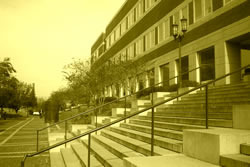|
|||||||
|
|
|
Home |

|
September 20th: Theories of DesignAnnouncements
Plan for the Day We've got a few things to do today, so below is a list:
We go over this every class, but you need to have the vocabularly to talk about visual rhetoric. Therefore,
Please consider the above elements when doing your assignments and use the terms in your discussions and memos. Let's take a look at an example of Logos, using logic. I have a couple flyers to critique, assuming we have time. Practical Piece: Let's learn how to place "anchors" (sometimes called bookmarks) within pages. We won't cover all of Ch. 4 in Document Design because we had to finish up last week's discussion. I'm assuming you can fold paper and printing technologies is really a course in itself. In fact, the book mentions printing production and offset lithography is covered in Ch. 11...I didn't even assign that chapter, so don't worry about having to fold paper or knowing how books are made for the final. Knowing what a codex (p. 103) is, however, could score you some points at a party. Today we'll mainly focus on document layouts, but, before we get there, I have a question for you about portability (a human factor). Jump on over to p. 78 in Document Design. Ch. 4 of Document Design mentions a term for considering the whole document--supratextual elements (p. 72). This term comes from Charles Kostelnick's "12-cell schema of Visual Communication." For those of you who have Tim Peeples Professional Writing and Rhetoric, the entire table is on p. 274. Below is an incomplete version of the table: We'll focus on column one, Alphanumeric/Symbolic. Practical Piece: Let's learn how to put tables into Dreamweaver. Insert --> Table Perception, Culture, and Rhetoric It's time for some group work. I have a "complex fold document" and an "accordian fold" document to show and discuss: The Vonage V-Portal Phone Adapter (a PDF version). Now, if we have time, let's get into groups and examine the following documents to determine how their layout, construction, and supratextual elements affect the documents' use. Consider the PDFs as documents intended to be printed. If we're short on time, analyze these in two weeks, and write up a response based on the criteria in the next section. We'll discuss these then as a larger class, and I'll also ask you to post this on Moodle or your web pages. Just have something electronic (e.g., Word Doc), so you can cut and paste the text into a window. Group/Row #1
Group/Row #2
Group/Row #3
Group/Row #4
Group/Row #5
Group/Row #6
Additionally, don't forget to consider the document for perceptual, cultural, and rhetorical perspectives. Continuing in your groups, discuss the following with regard to your document:
Two more things to address about knowing audience's technical limitations (their tools) from page 85:
Let's talk about Ch. 4 in The Non-Designer's Design Book. Thinking about our discussion above, what can we say about repetition and elements of a document? Can you believe it's just one week before the midterm exam? Unbelievable. Well, you have nothing to fear if you've been coming to class and reading. The midterm will focus mainly on the Document Design (Ch. 1-4) textbook, but there will be material from The Non-Designer's Design Book (Ch. 1-4). The exam's format will be multiple choice, fill-in-the-blank, and short answer. Workshop: Advertisement or Flyer PDF anyone? After you finish the midterm next week, please work quietly on your Document #2--Advertisement and Flyer. If you're finished with your workshop, please move on to the next two web page requirements. Please have others look at your designs, but, of course, please be quiet while others are taking the midterm. I expect that you will comment on a fellow classmate's document. Look at the assignments page for more details. Remember, I expect you to work the entire time. Picture Frame: I want you to create an InDesign document on your own with help from this tutorial. You'll be creating a "Picture Frame" that you will link to from your homepage. Easy Logo: Also, you need to create a logo using Photoshop. This logo is MUCH easier than the one you attempted a few weeks ago. I have part of the tutorial up but will put up the rest of the tutorial later. The above requirements do not need to be finished the night of the midterm. Fit them in when you can. Your participation grade can go negative, so use your time wisely--no Facebook updating. Make sure you read Chapter 5 in Document Design and Chapter 5 in The Non-Designer's Design Book before coming to class in two weeks (10/04). Of course, don't forget Document #2 (and the memo) is due in two weeks! We're going to focus more on nuts and bolts in our next full class (10/04), so I want you to bring in or find links to whole documents that you feel are either effective or ineffective. I'll ask you to comment on them on your webpages, so try to find documents that you feel you can discuss in terms of ______, _______, and ______. Guess what three words go in the blanks above? On the exam day, after you finish the exam, you can workshop Document #2: The Flyer OR Advertisement.
.. |
||||||||||||||||||||||||||||||||||||||||||||
|
|
|||||||||||||||||||||||||||||||||||||||||||||
| © UNC Charlotte Copyright | Privacy Statement | Page Maintained By: Aaron A. Toscano |
